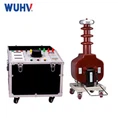What Is Resonant Testing? (Detailed Overview)
Resonant testing is a high-voltage AC testing method that uses the principle of series resonance to generate high test voltages efficiently and safely. Instead of using a direct full-power AC source at power frequency (50/60 Hz), resonant testing adjusts the frequency of the input voltage to create resonance between an inductive element (reactor) and the capacitance of the test object (e.g., cable, transformer winding).
Core Principle: Series Resonance
The test object (usually capacitive in nature) and the inductive reactor form a series LC circuit.
At the resonant frequency f0f_0f0, inductive reactance XL=2πfLX_L = 2 \pi f LXL=2πfL equals capacitive reactance XC=12πfCX_C = \frac{1}{2 \pi f C}XC=2πfC1, minimizing the circuit's overall impedance.
This allows a large voltage to develop across the capacitive test object while the current drawn from the power source remains low.
This resonance effect amplifies the voltage across the test object, often by a factor equal to the quality factor QQQ of the circuit.
Why Use Resonant Testing?
High Voltages with Low Input Power: Resonance drastically reduces the power required from the test supply.
Long Duration Tests: Suitable for long withstand tests (e.g., 60 minutes) required by standards.
Voltage Stability: The system automatically adjusts frequency to maintain resonance despite slight changes in capacitance or temperature.
Sinusoidal Voltage Waveform: Essential for partial discharge testing and to avoid damage from non-sinusoidal voltages.
Portable Equipment: Resonant systems can be made compact and trailer-mounted for on-site testing.
Components of a Resonant Test System
| Component | Function |
|---|---|
| Variable Frequency Power Supply (VFPS) | Provides AC voltage with adjustable frequency (usually 20–300 Hz). |
| Excitation Transformer | Steps up voltage from VFPS to a level suitable to excite the reactor. |
| High-Voltage Reactor (Inductor) | Creates inductive reactance forming resonance with the test object capacitance. |
| Test Object | The device under test, acting as a capacitive load (e.g., cable, transformer winding). |
| Voltage Divider | Measures the high voltage output for control and safety monitoring. |
| Control Unit (PLC/HMI) | Automates frequency tuning, voltage ramp-up, monitoring, and safety shutdown. |
| Discharge Circuit | Safely discharges stored energy after the test. |
Step-by-Step Resonant Testing Procedure
Preparation:
Measure or estimate the capacitance of the test object.
Calculate the required reactor inductance and approximate resonant frequency.
Connect the test object to the system and verify all safety interlocks.
System Setup:
Set initial frequency near calculated resonance.
Start the system at low voltage, gradually increasing voltage while tuning frequency to minimize input current (achieving resonance).
Voltage Ramping:
Slowly ramp voltage to the required test level (e.g., 1.2 times rated voltage) to avoid electrical stress.
Monitor voltage, current, and partial discharge signals continuously.
Sustained Test:
Maintain test voltage for specified duration (typically 60 minutes).
Automatic frequency adjustments compensate for temperature or test object changes.
Test Completion:
Ramp down voltage slowly.
Activate discharge circuits to safely release stored charge.
Document test data and analyze for insulation integrity.
Advantages Over Other Methods
| Advantage | Explanation |
|---|---|
| Energy Efficiency | Uses minimal input power thanks to resonance. |
| Equipment Portability | Smaller, mobile systems compared to power-frequency. |
| Better Voltage Waveform | Nearly perfect sinusoidal waveforms. |
| Enhanced Safety | Automatic detuning on fault detection. |
| Extended Test Duration | Allows long, continuous withstand tests. |
Common Applications
XLPE Cable Testing: Long underground or submarine cables.
Transformer Winding Testing: Factory or field acceptance.
Gas-Insulated Switchgear (GIS): High-voltage insulation verification.
Rotating Machines: Stator winding insulation testing.
Bushings & Insulators: Withstand voltage and partial discharge tests.
Challenges and Considerations
Capacitance Estimation: Accurate knowledge of test object capacitance is crucial for tuning resonance.
Complexity: Requires skilled operators and control systems.
Initial Investment: Higher upfront cost compared to simpler DC or VLF testers.
Low Capacitance Loads: Resonant testing is less practical for devices with very low capacitance (e.g., small bushings) without additional components.
Summary
Resonant testing is a precise, efficient, and industry-standard method for high-voltage AC insulation testing. By exploiting the physics of resonance, it minimizes power consumption while providing stable, high-voltage test conditions to verify insulation integrity and safety before equipment energization.




